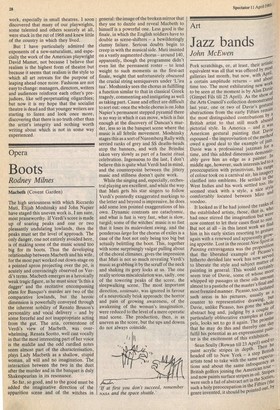Art
Jazz bands
John McEwen
Pork scratchings, or, at least, their artist equivalent was all that was offered by inc),s,' galleries last month, but now, with Apra, a. certain amplitude returns — and about tune too. The most exhilarating new wort' to b. e seen at the moment is by Alan Davie (Gimpel Fils till 25 April). As the show of the Arts Council's collection demonstrated last year, one or two of Davie's gestural abstractions from the early Fifties rental° the most distinguished contributions by a British artist to that still much abused pictorial style. In America — and it wa, s American gestural painting that Davi! espoused — the improvisation of the met"' owed. a good deal to the example of jazz' Davie was a professional jazzman for 9 time, and this added dimension demonstrably gave him an edge as a painter.In middle age, however, such interests led to preoccupation with primitivism, his range of colour took on a carnival air, hisiinageilY clarified into emblems. He settled in tjf West Indies and his work settled too. ne seemed stuck with a style, a nice stYle, comfortably located between Miro and voodoo. It looked as if he had joined the ranks of the established artists, those, that is, who had once stirred the imagination but were now content to let their cases float to re.ata But not at all in this latest work we fill him in his early sixties resorting to gesture i ,r , again with a renewed and apparently gip' , ng appetite. Lost in the recent New Spirit in ng appetite. Lost in the recent New Spirit in Painting extravaganza was the prOP05it10.II that the liberated example of Picasso s. hitherto derided late work has now serve°, to liberate the style and subject matter. or painting in general. This would certainly, seem true of Davie,some ot whose whipped up passages in these oils amour!, almost to a pastiche of the master's final ant', most frenzied manner. Picasso , too, isolateoa such areas in his pictures, usually as t counter to representative drawing, bu, Davie, unlike Picasso, has gone the whri'ef abstract hog and, judging by a e"Pille.,.,1°. particularly obliterative examples at pels, looks set to go it again. The prothiSc that he may do this and thereby one day fulfil his potential as an expressionist painter is the excitement of this exhibition, to Sean Scully (Rowan till 23 April) used. e paint acrylic stripes in depth. Theo. .ilh headed off to New York — a step sa. artists tend to take with the same expect; a tions and about the same infrequeneY British golfers joining the American tou. res and now paints surface stripes in oil. Strip s were such a fad of abstract art in the S (the ncti such a holy preoccupation in die Fifties . genre invented, it should be pointed out, IV Paul Klee in the Thirties), that anyone Persisting with them now, when they are out of fashion as well as long since done to ,....entb, must command respect. Scully used h`k! be a bit of a faddist but America sobered UP. It looked, indeed, as if he was destined to be a corporation artist — a producer of serious, anonymous, preferably ginormous works of `Lirt' to be hung meaningfully on an ongoing and day to day True, from bank to bank and year to year. 'rue, there was a tender Englishness in his pictures delicacy of detail and unboastful size, but, as is still the case with some of those in the present show, a deadening machine precision as well about the carefully scotch-taped lines, a deadening predictability about the elegant monochromes. Now Scully shows a definite and cheering impatience with fuss and safety. He is still striping and will have to stripe till the end of his daysif he is not to destroy his hard won credibility — but with more gusto both of stroke and colour than before. The latest Pictures here even convey a new sense of eLnjurnent, the confidence of a man who ties secured his player's card.











































 Previous page
Previous page